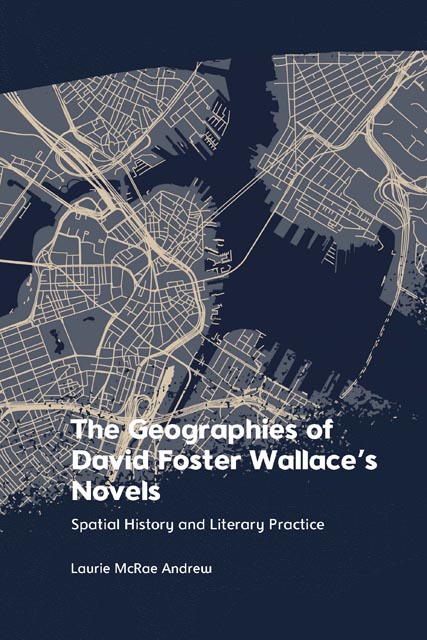Book contents
- Frontmatter
- Contents
- Acknowledgements
- Texts and Abbreviations
- Introduction
- 1 ‘This strange, occluded place’: Regional Geography, the Midwest and The Broom of the System
- 2 ‘Abroad in the urban night’ (I): Metropolis, ‘Postmetropolis’ and Infinite Jest
- 3 ‘Abroad in the urban night’ (II): Empathy, Community and the Image of the City in Infinite Jest
- 4 What is Peoria for? (I): Postindustrial Life and the Language of Place in The Pale King
- 5 What is Peoria for? (II): Peoria, the Edge City and The Pale King
- Bibliography
- Index
Introduction
Published online by Cambridge University Press: 13 April 2023
- Frontmatter
- Contents
- Acknowledgements
- Texts and Abbreviations
- Introduction
- 1 ‘This strange, occluded place’: Regional Geography, the Midwest and The Broom of the System
- 2 ‘Abroad in the urban night’ (I): Metropolis, ‘Postmetropolis’ and Infinite Jest
- 3 ‘Abroad in the urban night’ (II): Empathy, Community and the Image of the City in Infinite Jest
- 4 What is Peoria for? (I): Postindustrial Life and the Language of Place in The Pale King
- 5 What is Peoria for? (II): Peoria, the Edge City and The Pale King
- Bibliography
- Index
Summary
In his 1992 essay on the landscapes of the Midwest, ‘Derivative Sport in Tornado Alley’, David Foster Wallace wrote: ‘the only part of Proust that really moved me in college was the early description of the kid’s geometric relation to the distant church spire at Combray’ (Supposedly p. 11). Space and place, this line suggests, were central to Wallace’s literary imagination. But at the same time, the uneasy juxtaposition of geometry and affect, mathematical abstraction and emotional engagement, is an indication that geography, for this writer, was not a simple matter. Interviewing Wallace for a Rolling Stone feature (that would never in fact appear in the magazine), David Lipsky recalls being given a tour of Wallace’s home: among the assorted furnishings, he notes ‘globes from [an] old cartography thing’. This is a tantalising hint at an explicit engagement with practices of geographical representation; no such ‘cartography thing’ has appeared in print. A clue to its nature, though, might be found in the ‘Eschaton’ scene in Infinite Jest, in which the map of cold war geopolitics and the space of the tennis court are brought into collision, with chaotic results – and to the dismay of the game’s overseer Michael Pemulis, who exclaims: ‘“it’s snowing on the goddamn map, not the territory, you dick!”’ (Jest p. 333). Space and its mediations were not easy to separate in Wallace’s imagination, it seems: ‘I like to mess with maps a little bit’, he admitted in a 1996 interview. He set all three of his novels in recognisable American places – Cleveland, Boston, Peoria – but this geographical familiarity is counterposed with wildly speculative elements. He embellished the landscape of Ohio with an artificial desert of black sand; redrew the diplomatic map of the North American Free Trade Agreement as the ‘Organization of North American Nations’ and placed a vast ecological disaster zone in the middle for good measure; and populated an ordinary Peoria office building with ‘actual, non-hallucinatory’ ghosts (Pale King p. 317). Wallace’s imagination was a deeply spatial one; but one in which space was always a problem, not a solution. This book explores the richly generative problems – aesthetic, social and political – that geography poses in his novels.
- Type
- Chapter
- Information
- The Geographies of David Foster Wallace's NovelsSpatial History and Literary Practice, pp. 1 - 25Publisher: Edinburgh University PressPrint publication year: 2022



